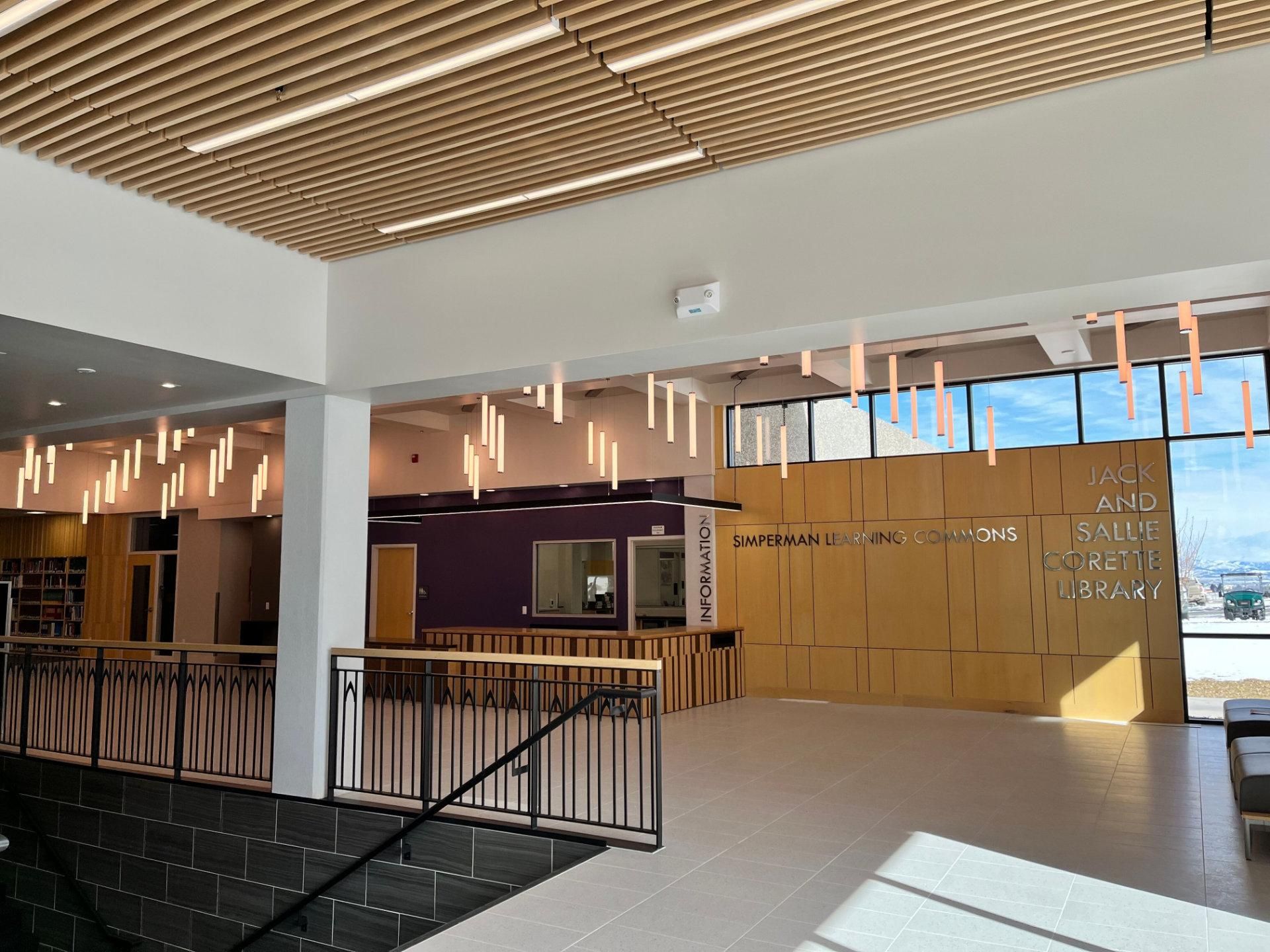Project Inspiration and Goals:
Q: Can you share what inspired the library remodel and the primary goals Carroll aimed to achieve with these changes?
A: The upper-level renovation is the second phase of the Library renovation. The first phase saw the renovation of the lower level and the creation of the Simperman Learning Commons with the Communication and Writing Centers, Podcasting Studio, Greenscreen/Lightboard Room, and Makerspace. The Simperman Learning Commons was established to support communication in various forms, including writing, oral presentations, videos, podcasts, and more. Both phases have been funded, in part, by Roy and Frances Simperman. The second phase builds upon the successes of the lower floor remodel, including adding more visible support, particularly post-production support, for audio and video projects, 3-D printing, and academic technology in general.
Q: How did feedback from student surveys specifically influence the design and features of the remodeled library?
A: Student feedback remains vital to the Library and Learning Commons and was crucial to the renovation designs. Many of the core features of the renovation are based on student requests. These include more study rooms, more windows, a 24/7 study area, new bathrooms, and more mobile whiteboards.
Study Rooms and Spaces:
Q: What considerations were made in determining the number and design of the additional study rooms?
A: We wanted as many new study rooms as the space would allow, as these are the most popular spaces in the Library. Reducing the staff area, designed before the rise of e-books, provided the necessary space to double our study room offerings. We were also able to create a more effective and efficient staff area.
Q: How does the Fireside Room's design and 24/7 availability cater to students' study habits and needs?
A: Students wanting 24/7 Library access has been a constant theme in our surveys. While 24/7 access to the Library is not practical for security and staffing reasons, we hope the Fireside Room (with access to bathrooms) will safely and effectively meet student needs for a 24/7 study space.
Technology and Innovation:
Q: Can you elaborate on the decision to include a Tech Corner in the remodel, and how you envision it enhancing student learning and creativity?
A: While the addition of the Podcasting Studio, Greenscreen/Lightboard Room, and Makerspace was a success in the first phase of the renovation, we quickly learned that we lacked centralized support for these services (and technology in general). The new CITE corner is a visual centerpiece of the renovation and a space that invites collaboration. The Podcasting Studio and Makerspace relocation to the CITE Corner allows Academic Technology to provide shoulder-to-shoulder technology support at the site of need. CITE also offers a dedicated space for Academic Technology to provide support and access to their resources.
Q: What are the specific capabilities of CITE’s podcasting room, makerspace with 3-D printing, and post-production support areas?
A: The Podcasting Room provides a dedicated space with sound-mitigating walls for recording podcasts, audio interviews, etc. Previously, the podcasting equipment was on a mobile table that was rolled into whatever space was available in the Library. Having a Podcasting Room improves access and allows those recording to better manage background noise and distractions. CITE will include two video editing stations, one with a docking station for students who want to use their laptops. These stations feature extra-wide monitors designed for video editing.
Collaboration and Academic Support:
Q: How do the new features, such as more mobile whiteboards and the visible Tutoring Room, facilitate collaboration and academic support among students?
A: Previously, the upper floor of the Library only had tables and some comfy furniture in the study areas. Now, we have study rooms (for 1-3 students), booths, study tables for 2- 6 students, and the new CITE corner for technology support. The CITE corner and Tutoring Room, in particular, all lend themselves to collaboration.
Q: In what ways do you anticipate the remodeled library will impact tutoring services and student collaboration?
A: Previously, the Tutoring Room was hidden and hard to find. We hope the more visible Tutoring Room will increase awareness and use of Carroll’s Tutoring services. We also hope the Tutoring Room will be used for collaborative study when tutoring sessions are not taking place.
Community and Feedback:
Q: How has the initial response from the student body and faculty been to the remodeled library?
A: Students are excited but have been understandably frustrated by the lack of access to the Library during the Renovation. We have given tours to the Gold Team, and our student workers have seen the transformation of the space. Both groups are very excited and have told others the wait will be worth it. We hope the student body as a whole will agree!
Q: Are there plans for ongoing assessment or feedback mechanisms to ensure the new library space continues to meet the needs of its users?
A: The Library takes feedback from students, faculty, and staff very seriously. We will:
- Continue our annual Student Satisfaction Survey every fall (or, for this year, in the spring) to solicit student feedback and assess our services and spaces;
- Reinstate our annual Usability Study, which focuses on the usability of our website, and
- Continue to explore other ways to get feedback from our users.
Future Plans:
Q: How do you envision the library evolving to meet future educational and technological advancements?
A: The renovation was planned with the future in mind. We view the updated space as a canvas that we can adapt as library, education, and technology needs change. Robby Whited (IT Department Director) ensured our internet and wireless infrastructure would see us well into the future. As he has said, the new wiring takes the building from the twentieth century into the twenty-first century. Modular furniture throughout the space means we can adapt our layout to meet changing student needs. Similarly, the computer labs (one of which is a mobile lab using laptops) and CITE corners were conceived with change in mind. The spaces were designed to be adaptable in terms of technology and furniture.

